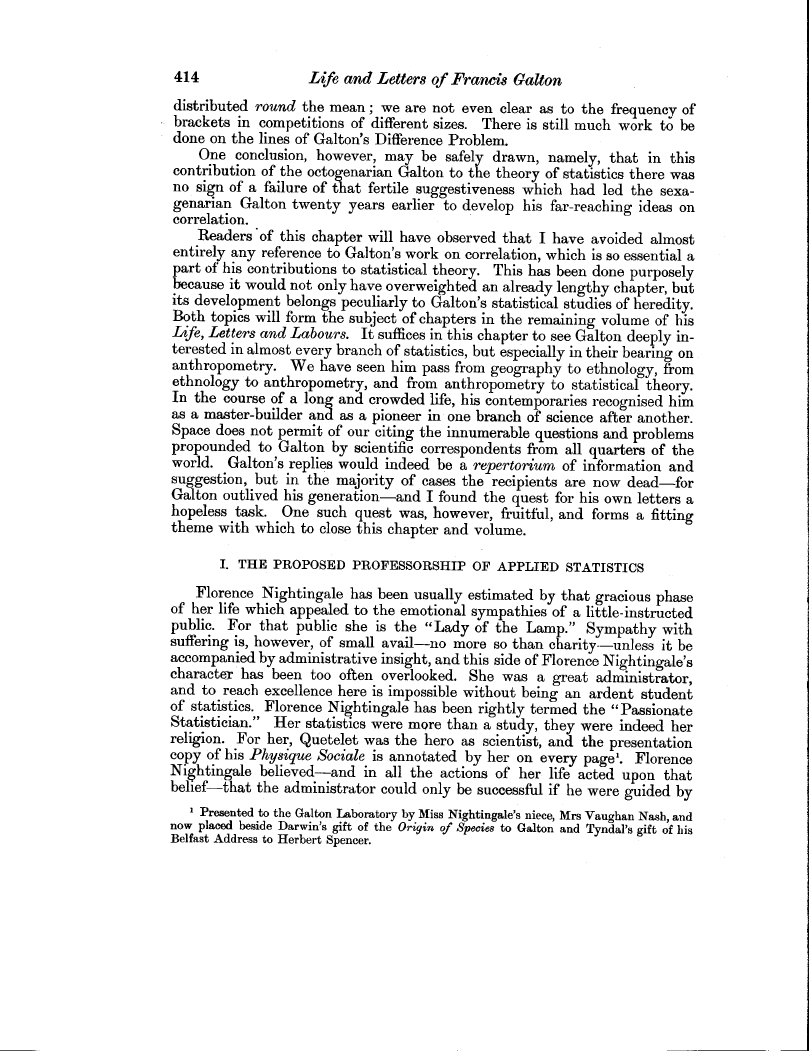414 Life and Letters of Francis Galton
distributed round the mean ; we are not even clear as to the frequency of brackets in competitions of different sizes. There is still much work to be done on the lines of Galton's Difference Problem.
One conclusion, however, may be safely drawn, namely, that in this contribution of the octogenarian Galton to the theory of statistics there was no sign of a failure of that fertile suggestiveness which had led the sexagenarian Galton twenty years earlier to develop his far-reaching ideas on correlation.
Readers *of this chapter will have observed that I have avoided almost entirely any reference to Galton's work on correlation, which is so essential a part of his contributions to statistical theory. This has been done purposely because it would not only have overweighted an already lengthy chapter, but its development belongs peculiarly to Galton's statistical studies of heredity. Both topics will form the subject of chapters in the remaining volume of his Life, Letters and Labours. It suffices in this chapter to see Galton deeply interested in almost every branch of statistics, but especially in their bearing on anthropometry. We have seen him pass from geography to ethnology, from ethnology to anthropometry, and from anthropometry to statistical theory. In the course of a Ion and crowded life, his contemporaries recognised him as a master-builder and as a pioneer in one branch of science after another. Space does not permit of our citing the innumerable questions and problems propounded to Galton by scientific correspondents from all quarters of the world. Galton's replies would indeed be a repertorium of information and suggestion, but in the majority of cases the recipients are now dead-for Galton outlived his generation-and I found the quest for his own letters a hopeless task. One such quest was, however, fruitful, and forms a fitting theme with which to close this chapter and volume.
I. THE PROPOSED PROFESSORSHIP OF APPLIED STATISTICS
Florence Nightingale has been usually estimated by that gracious phase of her life which appealed to the emotional sympathies of a little-instructed public. For that public she is the "Lady of the Lamp." Sympathy with suffering is, however, of small avail-no more so than charity--unless it be accompanied by administrative insight, and this side of Florence Nightingale's character has been too often overlooked. She was a great administrator, and to reach excellence here is impossible without being an ardent student off statistics. Florence Nightingale has been rightly termed the "Passionate Statistician." Her statistics were more than a study, they were indeed her religion. For her, Quetelet was the hero as scientist, and the presentation copy of his Physique Sociale is annotated by her on every page'. Florence Nightingale believed-and in all the actions of her life acted upon that belief-that the administrator could only be successful if he were guided by
1 Presented to the Galton Laboratory by Miss Nightingale's niece, Mrs Vaughan Nash, and now placed beside Darwin's gift of the Origin of Species to Galton and Tyndal's gift of his Belfast Address to Herbert Spencer.

